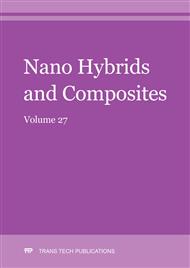[1]
K. Johnston, S. K. Pavuluri, M. T. Leonard, M. P. Y. Desmulliez, and V. Arrighi, Microwave and thermal curing of an epoxy resin for microelectronic applications,, Thermochimica Acta, 616 (2015) 100–109.
DOI: 10.1016/j.tca.2015.08.010
Google Scholar
[2]
J. Mirza, M. S. Mirza, and R. Lapointe, Laboratory and field performance of polymer-modified cement-based repair mortars in cold climates, Construction and Building Materials, 16(6), (2002) 365–374.
DOI: 10.1016/s0950-0618(02)00027-2
Google Scholar
[3]
J. M. L. Reis, Fracture and flexural characterization of natural fiber-reinforced polymer concrete, Construction and Building Materials, 20(9), (2006) 673–678.
DOI: 10.1016/j.conbuildmat.2005.02.008
Google Scholar
[4]
M. Golestaneh, G. Amini, G. D. Najafpour, and M. A. Beygi, Evaluation of mechanical strength of epoxy polymer concrete with silica powder as filler, World Applied Sciences Journal, 9 (2010) 216–220.
Google Scholar
[5]
D. W. Fowler (1999), Polymers in concrete: a vision for the 21st century, Cement and Concrete Composites, 21(5-6), (1999) 449–452.
DOI: 10.1016/s0958-9465(99)00032-3
Google Scholar
[6]
AC1 Committee 548, Guide for Polymer Concrete Overlays, ACI Materials Journal, 90(5), (1993) 499-522.
Google Scholar
[7]
J. T. San-Jos´e, I. Vegas, and A. Ferreira, Reinforced polymer concrete: physical properties of the matrix and static/dynamic bond behaviour, Cement and Concrete Composites, 27(9-10), (2005) 934–944.
DOI: 10.1016/j.cemconcomp.2005.06.004
Google Scholar
[8]
P.Ravikumar, Vinodhini Ellappan and Dr. T. Sundararajan, The mix proportion and strength of polyester resin concrete with various microfillers, International Journal of Civil Engineering and Technology, 9(5), (2018) 1042–1050.
Google Scholar
[9]
Camille A. Issa and Pauls Debs, Experimental study of epoxy repairing of cracks in concrete, Construction and Building Materials, 21 (2007)157–163.
DOI: 10.1016/j.conbuildmat.2005.06.030
Google Scholar
[10]
Rahman, M.M., Islam, M.A. and Ahmed, M., Experimental studies on the application of polymer in concrete, Proceedings of a Seminar on Eco-housing, Ferro-cement floating house and polymer in concrete, Housing and Building Research Institute (HBRI), Dhaka, Annex-04, January (2009).
Google Scholar
[11]
ASTM C 881-90, Standard specification for epoxy-resin based bonding systems for concrete. West Conshohocken (PA): ASTM International; 5, (1990).
Google Scholar
[12]
ACI Committee 546, Concrete repair guide (546R-96). Farmington Hills (MI): American Concrete Institute; 41, (1996).
DOI: 10.14359/51687319
Google Scholar
[13]
ACI Committee 548.: Polymer Concrete – Structural Applications, State-of-the Art Report,, American Concrete Institute.
Google Scholar
[14]
ACI Committee E706, Structural crack repair by epoxy injection (ACI RAP Bulletin 1). Farmington Hills (MI): American Concrete Institute, 5, (2003).
Google Scholar
[15]
R. Bedi, R. Chandra, and S. P. Singh, Mechanical properties of polymer concrete, Journal of Composites, Article ID 948745, 12, (2013).
Google Scholar
[16]
A. Pratap, Vinyl ester and acrylic based polymer concrete for electrical applications, Progress in Crystal Growth and Characterization of Materials, 45(1-2), (2002) 117–125.
DOI: 10.1016/s0960-8974(02)00036-0
Google Scholar
[17]
J. Mirza, M. S. Mirza, and R. Lapointe, Laboratory and field performance of polymer-modified cement-based repair mortars in cold climates, Construction and Building Materials, 16(6), (2002) 365–374.
DOI: 10.1016/s0950-0618(02)00027-2
Google Scholar
[18]
K. Paderewski, Use of polymer concretes in machine tool construction, Przeglad Mechaniczny, 43(13), (1984) 12–15.
Google Scholar
[19]
A. Gandini andM.N. Belgacem, Furans in polymer chemistry, Progress in Polymer Science, 22(6), (1997) 1203–1379.
DOI: 10.1016/s0079-6700(97)00004-x
Google Scholar
[20]
Y. Ohama, Mix proportions and properties of Polyester Resin Concretes, American Concrete Institute, (1973) 283–294.
Google Scholar
[21]
M. E. Tawfik and S. B. Eskander, Polymer concrete from marble wastes and recycled poly (ethylene terephthalate), Journal of Elastomers and Plastics, 38(1), (2006) 65–79.
DOI: 10.1177/0095244306055569
Google Scholar
[22]
M. Muthukumar, D. Mohan, and M. Rajendran, Optimization of mix proportions of mineral aggregates using Box Behnken design of experiments, Cement and Concrete Composites, 25(7), (2003) 751–758.
DOI: 10.1016/s0958-9465(02)00116-6
Google Scholar
[23]
Y. Ohama and K. Demura, Relation between curing conditions and compressive strength of polyester resin concrete, International Journal of Cement Composites and Lightweight Concrete, 4(4), (1982) 241–244.
DOI: 10.1016/0262-5075(82)90028-8
Google Scholar
[24]
A.Gopinath, M. S. Kumar, and A. Elayaperumal, Experimental investigations on mechanical properties of jute fiber reinforced composites with polyester and epoxy resin matrices, Procedia Engineering, 97, (2014) 2052–(2063).
DOI: 10.1016/j.proeng.2014.12.448
Google Scholar
[25]
A. Kumar, G. Singh, and N. Bala, Evaluation of flexural strength of epoxy polymer concrete with red mud and fly ash, International Journal of Current Engineering and Technology, 3, (2013) 1799–1803.
Google Scholar
[26]
Y. Ohama, Polymer-Modified Mortars & Concretes. Concrete Admixtures Handbook: Properties, Science, and Technology, (1984) 558-656.
DOI: 10.1016/b978-081551373-5.50013-1
Google Scholar
[27]
A. Blaga, and J.J. Beaudoin, Polymer Modified Concrete. Canadian Building Digest, (1985).
Google Scholar
[28]
K. S. Rebeiz , Precast use of polymer concrete using unsaturated polyester resin based on recycled PET waste, Construction and Building Materials, 10(3), (1996) 215–220.
DOI: 10.1016/0950-0618(95)00088-7
Google Scholar
[29]
K. S. Rebeiz, Time-temperature properties of polymer concrete using recycled PET, Cement and Concrete Composites, 17(2), (1995) 119–124.
DOI: 10.1016/0958-9465(94)00004-i
Google Scholar
[30]
Mohammad Ismail, Bala Muhammad, Jamaluddin Mohd Yatim, Ainul Haezah, Noruzman, Yong Woo Soon, Behavior of Concrete with Polymer Additive at Fresh and Hardened States, Procedia Engineering, 14 (2011) 2230-2237.
DOI: 10.1016/j.proeng.2011.07.281
Google Scholar


